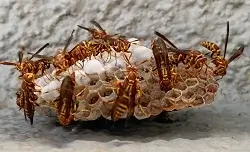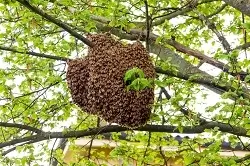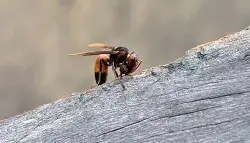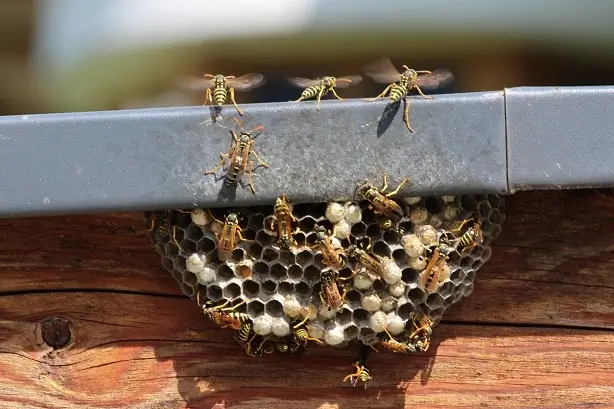
Wasps
Quick, Guaranteed Yellow Jacket / Wasp Control
Welcome to Idaho Beeline Pest Control, your definitive source for wasp control and extermination. Nestled in the heart of Idaho, we specialize in identifying, controlling, and eliminating wasps, ensuring your outdoor spaces are safe and enjoyable. With our deep understanding of wasp behavior and the unique challenges they present in Idaho, we offer tailored solutions to protect your home, family, and pets from these stinging pests. Trust in our expertise to deliver effective and environmentally responsible wasp management services.
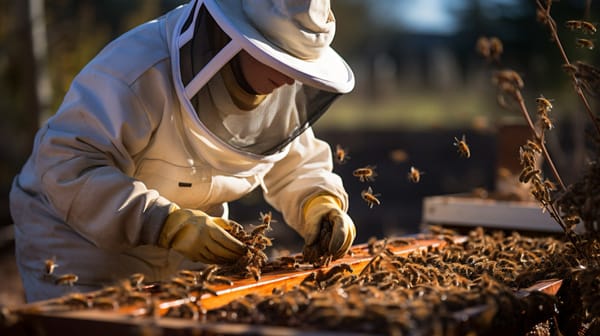
Wasps
Regular old Paper Wasps are the most common kind we get here in Idaho. Nearly every home in Idaho has at least one nest on it but we often see homes with anywhere from 5 to 25 nests on them.
Yellow Jackets
Yellow Jackets may look a lot like the common Idaho Paper Wasp, but their nest have quite a different meaning for your family.
Bees
The common honey bee is the “friendliest” on this list of stinging pests. They are the least likely to sting your family.
Hornets
Hornets in Idaho can usually be identified by their nest or hive. They build a large football shaped nest like the one in the picture above. These nests are usually hanging in a tree, but can sometimes be hanging on structure such as your home, shed or playset.
The paper wasp, known for its umbrella-shaped nests, tends to be less aggressive but can sting when provoked. Yellow jackets, on the other hand, are more aggressive and often build nests underground, making them harder to detect and treat. Hornets are the largest and can be very aggressive, especially when their nests are disturbed.
Their life cycles generally begin in spring when the queen emerges from hibernation to start a new colony. By late summer, these colonies can grow significantly, leading to increased wasp activity and potential conflicts with humans. Understanding these patterns is crucial for effective control and prevention. Similarly, you have to understand patterns for effective cockroach treatment and control services.
Wasps, while beneficial for the ecosystem, can pose significant health risks to humans, especially those allergic to their stings. The severity of wasp stings can range from a painful nuisance to life-threatening allergic reactions. Recognizing the signs of an allergic reaction is vital. Symptoms can include swelling, redness, hives, difficulty breathing, and anaphylaxis in severe cases. Immediate medical attention is crucial for severe reactions.
To minimize risks, it’s important to:
- Avoid provoking wasps.
- Stay calm and move slowly when near them.
- Wear protective clothing in areas with high wasp activity.
- Use insect repellent when necessary.
Detecting a wasp infestation early can prevent it from escalating into a more serious problem. Some key signs to watch out for include:
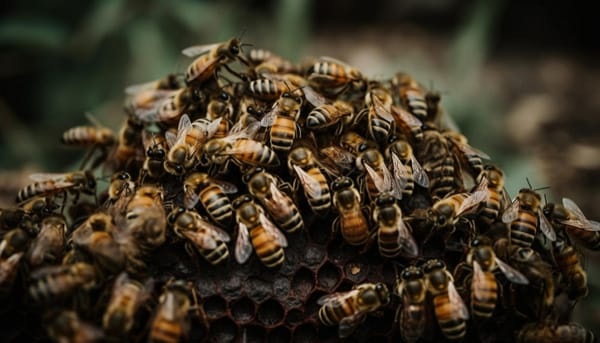
- The presence of wasp nests: These can vary in size and location, depending on the species. Paper wasps typically build open, umbrella-shaped nests, while yellow jackets prefer enclosed spaces or underground.
- Increased wasp activity: An unusual number of wasps around your property, especially near potential food sources, can indicate a nearby nest.
- Aggressive behavior: Wasps tend to become more aggressive if they feel their nest is threatened, which can be a sign of a nest close to your home.
Regular inspections around your property, especially during the warmer months, can help in early detection and prevention of wasp infestations. Also, utilize our professional ant control services to go in sync with wasp prevention.
Effective wasp prevention starts with understanding their behavior. Wasps are attracted to food, so keeping eating areas clean, covering food during outdoor events, and properly sealing garbage bins are key steps. Home maintenance also plays a crucial role; sealing cracks and crevices can prevent wasps from entering and nesting in homes. Landscaping choices, such as selecting plants less attractive to wasps and maintaining a tidy yard, can reduce the likelihood of nesting on your property.
Our innovative control techniques are designed to be both effective and eco-friendly. We use targeted insecticides that are safe for use around homes and pets but lethal to wasps. Trapping methods are strategically implemented to capture wasps without harming beneficial insects. Additionally, we employ the latest technology in nest detection, such as infrared cameras, to locate nests in challenging areas, ensuring comprehensive control and removal.
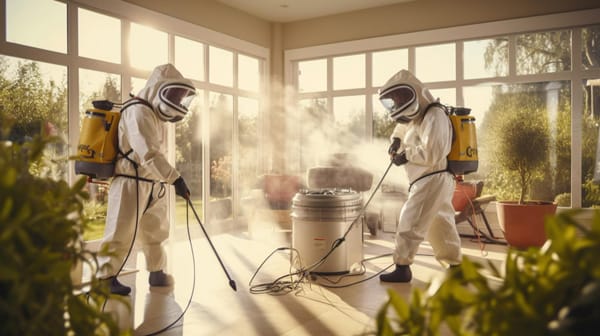
The safe removal of wasp nests is a task best left to professionals due to the high risk of stings and potential allergic reactions. Our team is equipped with the necessary protective gear and tools to safely remove nests. We assess each situation to determine the safest approach, whether it’s immediate removal or applying treatments to reduce the risk of aggression. Safety protocols are rigorously followed to protect not only our team but also the residents and pets during the removal process.
Our wasp control services include customized treatment plans that are specifically tailored to the needs of each property. We consider various factors such as the size and location of the property, the type of wasp species involved, and the severity of the infestation. This personalized approach ensures that we provide the most effective and efficient solution for each unique situation. Also want a customized spider removal plan? Get in touch today!
We believe in the importance of ongoing monitoring and support to ensure the long-term effectiveness of our treatments. This includes:
- Regular follow-up visits to check for signs of new wasp activity.
- Providing advice and support on how to maintain a wasp-free environment.
- Adjusting treatment strategies as needed based on monitoring results.
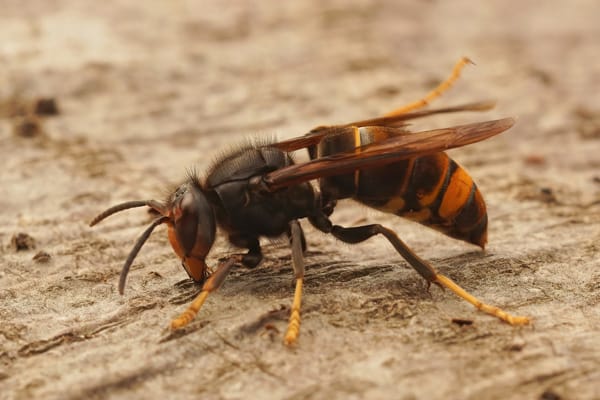
Our commitment to environmental responsibility is reflected in our choice of treatment methods and products. We use environmentally friendly and sustainable practices to minimize our ecological footprint. Our safety measures include:
- Using products that are safe for the environment, people, and pets.
- Following strict safety protocols to ensure the well-being of our clients and staff.
- Continually updating our methods and products to stay in line with the best environmental practices.
We also offer healthy and environmentally responsible bed bugs removal services.

- Check areas where nests can be built. Prevent them from building larger nests by removing small nests at first sight.
- Put a light in spaces where wasps like to gather and keep it on during the day. This will scare them away from that area.
- Make sure to seal off any area where wasps nest, cover all soffits.
Questions that People Most Frequently Ask Us
Take a look at some of the typical questions that pop up in the minds of our clients
How do wasps build their nests?
Wasps build their nests by chewing wood into a pulp. They then shape this pulp into the desired shape and allow it to harden. Once the nest is complete, the wasps will lay their eggs inside of it.
What should I do if a wasp is chasing me?
If a wasp is chasing you, it is likely because it feels threatened. Try to calm down and avoid making sudden movements. Once the wasp has flown away, you should be safe.
Where do wasps go in the winter?
Some types of wasps hibernate in the winter, while others die off. However, the queens of most wasp species survive the winter by burrowing into the ground and creating a cocoon. When spring arrives, the queen will emerge from her cocoon and begin to build a new nest.
Can wasps pollinate or make honey?
Yes, some types of wasps are able to pollinate flowers. However, wasps do not make honey like bees do. Instead, they make a substance called pollen that they use to feed their young.
Why do wasps keep coming back to my home or business?
If you have wasps on your property, it is likely because they have built a nest nearby. Wasps will often build their nests in trees or bushes, but they can also build them in the eaves of buildings.
Where do wasps live?
Most wasps live in nests that they build themselves. These nests can be found in a variety of locations, including trees, bushes, and even the eaves of buildings. In some cases, wasps will build their nests underground.
What time of day are wasps most active?
Wasps are most active during the day, especially when it is sunny outside. However, they can also be active at night, particularly if there is artificial light nearby.
Can a wasp sting more than once?
Yes, a wasp can sting more than once. In fact, some wasps can sting multiple times in quick succession. However, most wasps will only sting once and then fly away.
Are wasps dangerous?
While wasps are not typically aggressive, they can become dangerous if they feel threatened. If a wasp stings you, it can cause pain and swelling. In some cases, wasp stings can also cause allergic reactions.
What is a wasp?
A wasp is a winged insect that is related to bees and ants. Wasps are often brightly colored, with yellow and black stripes being the most common pattern. Some wasps can be up to an inch long, while others may be as small as a fraction of an inch.

